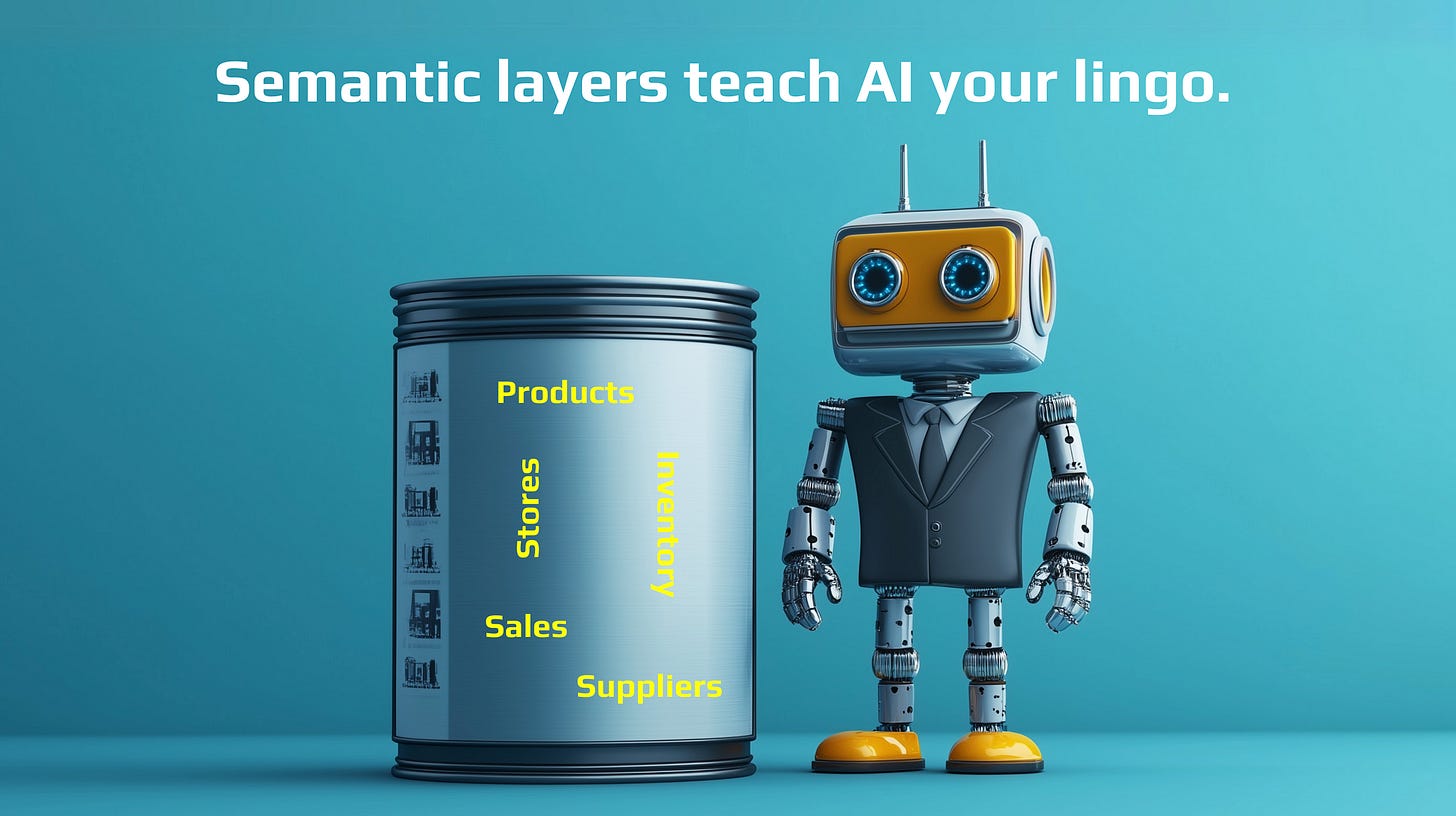Semantic Layers: BI's Gift to AI
Most think semantic layers only serve human business intelligence; the truth is, they're essential for enterprise artificial intelligence as well.
Most think semantic layers only serve human business intelligence; the truth is, they're essential for artificial intelligence as well. While semantic layers are typically used to power traditional human-readable dashboards and reports, they’re quickly becoming a critical foundation that enables AI agents to understand and operate on enterprise data. Semantic layers are BI’s gift to AI.
Research shows that semantic layers make AI responses 3X more accurate (54% vs 16%) compared to direct SQL database queries. Unlike BI tools that translate data for human consumption, semantic layers create a universal language that allows AI agents to comprehend and act on business context, relationships, and meaning across disparate data sources.
Six-Word Story
Semantic layers teach AI your lingo.
Conventional Wisdom: Semantic Layers are Just for BI
BI teams built it. AI stole it. A prevailing view is that semantic layers are primarily designed to make dashboards better. Instead, semantic layers are becoming the essential neural system for AI agents, enabling them to navigate complex enterprise data landscapes without human intervention. A semantic layer provides a bridge between the language of business and the language of data for both AI and humans.
Case Study: Home Depot
At the Semantic Data Summit, Rick Ramaker described how Home Depot utilizes conversational analytics and natural language interfaces to access its semantic data layer, which was initially built for BI. They experimented with alternative approaches, including direct natural language-to-SQL solutions. Rick’s team discovered that "going from natural language to an API call to our semantic layer was by far the best approach," yielding "really, really good results."
Home Depot's semantic layer contains curated data for the entire organization, making it the ideal foundation for AI agents and machine learning systems. Rather than having AI agents try to understand raw data or navigate complex database structures directly, the agents interact with the semantic layer through API calls.
This approach allows Home Depot to:
Leverage their existing investment in semantic modeling (their 20 terabyte semantic layer. More on this in a future post!),
Ensure AI responses are based on the same "golden set of data" that human analysts use with their BI tools,
Maintain consistency between BI and AI-generated insights,
Benefit from performance optimizations built into their semantic layer, and
Scale AI and BI across all business functions.
Ramaker says that this semantic layer approach to AI has become "a foundational piece of how we do data analytics at Home Depot: natural language talks to our semantic layer." The company is broadening deployment of AI agents that leverage their semantic layer as the knowledge foundation.
Leverage Semantic Layers for AI, Not Just BI
Modern semantic layers designed for AI agents extend beyond traditional business intelligence (BI) metadata by creating knowledge graphs that encode business rules, relationships, and context in machine-readable formats. These systems enable AI agents to understand not only what data means, but also how different concepts relate to each other and what actions are appropriate in various business contexts. This creates a foundation for autonomous AI operations that can scale beyond human-directed analytics.
So, start attaching your semantic layer to enterprise AI to improve the accuracy, trust, and creativity of AI!
21 Big Ideas from the 2025 Semantic Data Summit
This post is a part of a multi-part series on big ideas from the 2025 Semantic Data Layer Summit. It explores hot takes on topics like: Is data visualization dying, or is it just getting started? How can AI best leverage “real” data to ensure its insights are accurate? What role do data semantics play in the agentic automation applications of today and tomorrow?
Further Reading
For more on this idea and semantic layers in general, explore these resources:
21 Surprising Ideas About Semantic Layers, AI Agents, Generative AI, Business Intelligence, and Data Integration from the 2025 Semantic Layer Summit. This the is the master “rolling thunder” post with all the big ideas from the summit
The Techno Sapien Podcast: Semantic Layers 101. If you’re new to semantic layers.
A Benchmark to Understand the Role of Knowledge Graphs on Large Language Model Accuracy: https://arxiv.org/pdf/2311.07509
How Semantic Layers Make GenAI 3X More Accurate: https://www.atscale.com/blog/semantic-layers-make-genai-more-accurate/
The Great Semantic Layer Debate: Five Issues for AI Innovators: https://technosapien.substack.com/p/the-great-semantic-layer-debate-five
Top Semantic Layer Use Cases and Applications (with Real World Case Studies): https://enterprise-knowledge.com/top-semantic-layer-use-cases-and-applications-with-realworld-case-studies/
The Semantic Layer Summit 2025 (Replays): https://www.atscale.com/resource/2025-semantic-layer-summit-on-demand-sessions/



Knowledge graphs! I knew they'd be hiding in here somewhere. Great post.